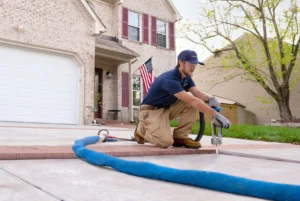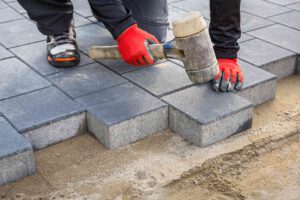If you have cracked and sinking concrete, the best solution is to pour a new slab. However, this can be expensive and only sometimes effective. For more information, just visit Concrete Lifting Cincinnati to proceed.
Fortunately, a much more affordable alternative is concrete lifting. This process involves injecting a foam designed to lift the existing concrete. The injections are made through holes less than an inch in diameter.

Whether you’re considering concrete lifting for your home or business, it’s important to understand the cost involved. The good news is that it’s much less expensive than pouring new concrete. Plus, it saves on demolition and removal costs. And it spares your lawn and flower beds from the destruction associated with concrete demolition and replacement.
Concrete lifting involves injecting a material underneath the concrete slab to raise it. The injected material may be mud, slurry, foam, or a combination. It is also possible to use soil in place of the injected material. The process is fast, which is a benefit compared to traditional remove-and-replace repair methods.
Concrete lifting can also help prevent future damage by addressing the root causes of the sinking. This is especially important for commercial properties, such as warehouses and retail stores, where people constantly walk on the concrete surface. If the ground is not properly compacted, it can erode over time, causing concrete to sink.
The best way to estimate the cost of a concrete lifting project is to contact a professional contractor. They will be able to provide you with a detailed estimate of the cost, as well as explain how the process works. They will also be able to identify any underlying issues causing the concrete to sink and recommend the best course of action.
Mudjacking is a popular method of concrete lifting. It involves drilling holes into the sunken concrete and pumping a mud-like substance, often a mixture of sand, limestone, and cement. The material is injected beneath the concrete, which lifts it and prevents further settling. Mudjacking is an affordable option and can be performed in hours.
Another alternative to mudjacking is polyurethane concrete lifting. It uses a similar technique as mudjacking but uses a lighter material and requires fewer injections. Polyurethane concrete lifting is more cost-effective than concrete replacement and can be completed in a few hours.
Concrete is a heavy material that can cause serious back injuries if it is carried incorrectly. Workers should use proper lifting and handling techniques, such as keeping their backs straight and knees bent when holding the concrete. They should also not twist their bodies while lifting the concrete and always have someone else push the load. In addition, they should wear personal protective equipment such as gloves and face protection rated for concrete work. If dust is present, workers should use a face mask or ventilator to avoid breathing it in.
Workers must also take precautions against chemical burns from wet concrete. Wet concrete is highly alkaline and can burn through clothing in a matter of hours. This is why wearing long sleeves and pants is important while working with concrete. Workers should also wear waterproof boots and safety glasses or goggles to protect their eyes from concrete splashes and dust.
Another risk associated with concrete lifting is exposure to crystalline silica dust, which can damage the lungs. This dust is created when mixing and pouring concrete and can become airborne. It can lead to immediate discomfort, such as wheezing and coughing; long-term exposure can even result in lung disease.
A final safety measure that every concrete lifting worker must take is to ensure that the concrete slab they’re lifting is secure. This can be done by providing that the ground underneath is sufficiently packed and that there are no structural issues or hazards. If there are, they should consult an expert to resolve them before lifting the concrete.
Concrete lifting is a great way to level uneven surfaces damaged by water erosion or other environmental factors. It’s an eco-friendly solution that’s also cost-effective and provides a guaranteed result. However, following all the safety measures mentioned above is crucial to prevent injury and accidents. These tips can also help improve productivity, maintain legal compliance, and decrease costs. By following these simple tips, contractors can ensure the safety of their workers and the success of their projects.
Discovering that concrete slabs within your home are sinking is frustrating, not only because of the negative impact on curb appeal but also because it can lead to tripping hazards, foundation issues, and more. But tearing up and replacing these slabs can be costly, messy, and disruptive to your home’s landscape. Fortunately, homeowners can now use concrete lifting, an innovative repair technique that takes much less time than traditional repouring.
This process involves injecting liquid into the sunken concrete, which becomes a rigid foam. This polyurethane foam is robust enough to support the concrete yet lightweight to reduce stress on unstable soils beneath your slabs. This helps to prevent future movement, making the lift sustainable and long-lasting. The injection holes required for this process are smaller than those used in traditional mudjacking or slab jacking, which helps minimize the repairs’ visual impact.
While this is a fairly quick repair method, the exact time depends on the size and condition of your concrete slabs. If your concrete is in good shape and has little settling, it may only require a few hours for contractors to complete the work. It could take longer if the concrete is in poor condition, with much void space underneath it.
Once the injection process is complete, your contractor will patch any access holes in the concrete. This is typically done with caulking, so the spots should be virtually undetectable afterward. Once the concrete has regained its original height, your contractor will test it to ensure it is safe.
Concrete lifting is a cost-effective and efficient solution for sunken concrete, particularly when the cause of the sinking is not obvious. If you have noticed that the sidewalks around your house are uneven or that your driveway panels are heaving, contact a concrete lifting specialist for a consultation. They can evaluate the condition of your concrete and recommend the best repair options. With the right professional, you can return to enjoying your home’s outdoor spaces in no time!
Concrete surfaces are used in various outdoor spaces, including driveways, sidewalks, and patios. They are strong and durable but can develop uneven or sunken sections over time, resulting in trip hazards. While it is possible to replace these areas with new slabs, this can be costly and time-consuming. Concrete lifting is a cost-effective and less disruptive alternative that can restore the safety and beauty of these spaces.
The process is also environmentally friendly, as it does not require the removal of the existing concrete and avoids landfill waste. The material injected into the recessed area comprises non-toxic, non-corrosive polyurethane foam. This material has high strength but is flexible enough to lift and level the sunken concrete.
Compared to the traditional method of laying new concrete, concrete lifting through slab jacking is much less invasive. New concrete installation requires large machinery that creeps on the property and disrupts nearby landscaping. Conversely, concrete lifting requires small equipment that pumps material into holes in the concrete. This results in less disruption and the process can be completed within a few hours rather than days for larger areas.
Another advantage of concrete lifting is that it does not require cement slurry. This liquid mixture is often messy and creates a mess that is difficult to clean up. Additionally, it has the potential to continue to settle over time, recreating the voids that caused the sinking. The foam used in concrete lifting, on the other hand, does not shrink or lose density over time.
While a new concrete slab can be beautiful, it can also look jarring when installed next to an older section. While it may be possible to match the color of a fresh concrete slab with that of the older one, it is unlikely that the new section will blend in seamlessly. Concrete lifting, however, can be completed quickly and inconspicuously, restoring the original appearance of your concrete surfaces. In addition, it is less likely to create a trip hazard and can be completed at a fraction of the cost of replacing the entire slab.


